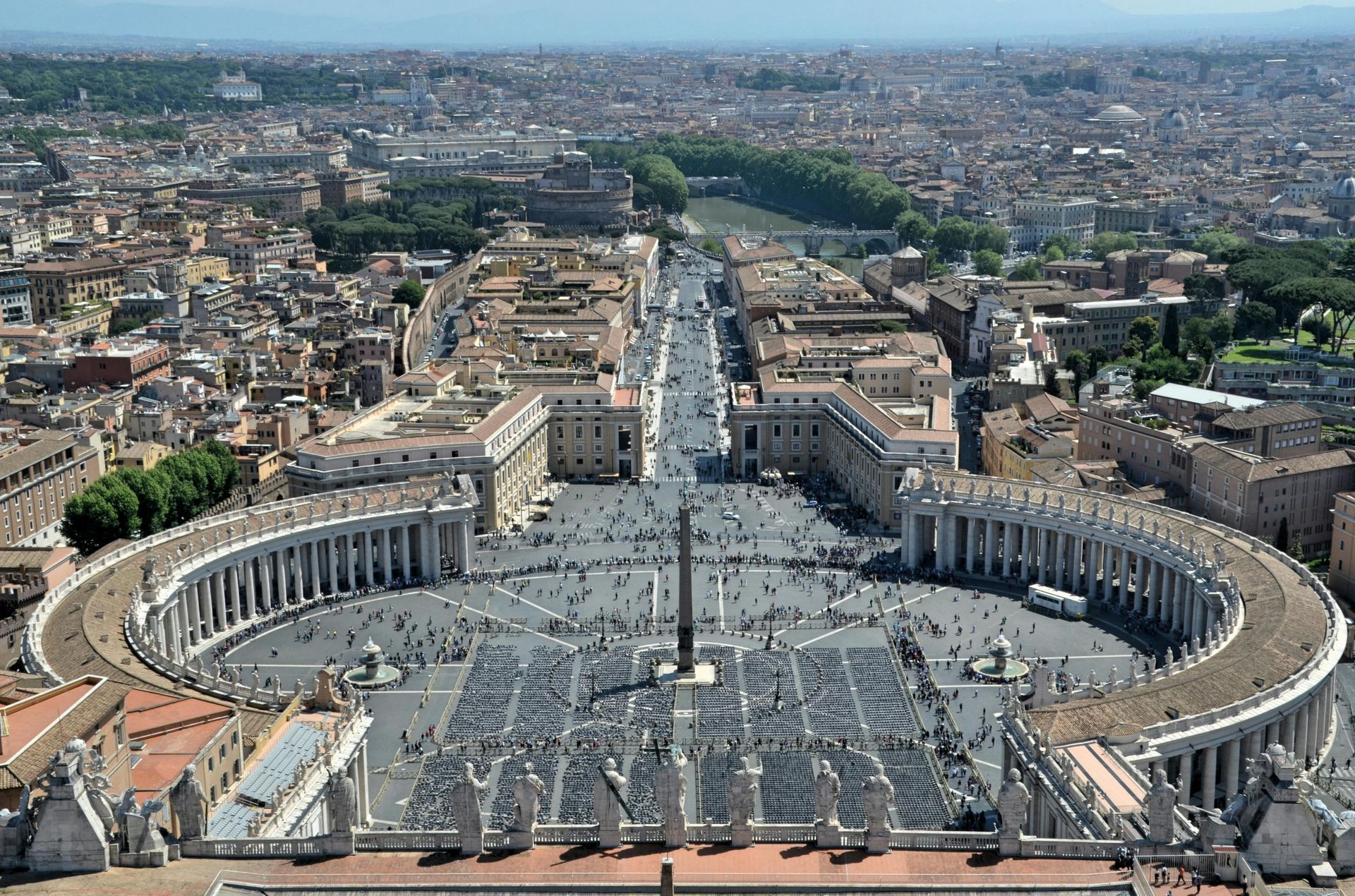Roman Holiday Dreams
Your Ultimate Guide to the Eternal City
Hotels in the Rome
Ancient Wonders, Renaissance Art, Pasta, Pizza, and La Dolce Vita Await
Welcome to Rome, the Eternal City! Italy's sprawling capital is a place where history breathes on every corner, ancient ruins stand alongside Renaissance masterpieces, Vespas zip down cobblestone streets, and the aroma of espresso and fresh pasta fills the air. For millennia, Rome has been a center of power, culture, and faith, leaving behind an unparalleled legacy that continues to awe visitors today. It's a city that truly has it all: iconic landmarks, world-class art, divine food, and an electric atmosphere buzzing with passion and life.
Imagine tossing a coin into the Trevi Fountain, standing in awe within the Colosseum where gladiators once fought, gazing up at Michelangelo's masterpiece in the Sistine Chapel, or getting lost in the charming, ivy-clad lanes of Trastevere. Rome is more than just a collection of sights; it's an immersive experience – chaotic, beautiful, historic, and utterly captivating. It's a city that demands exploration and rewards you with unforgettable memories at every turn.
This guide is designed to help you, our American travelers, navigate the magnificent chaos and discover the magic of Rome. We'll cover getting there, the best times to visit, must-see attractions, and essential tips for experiencing la dolce vita (the sweet life). Andiamo! (Let's go!)
Getting to Rome from the USA
Your Roman adventure will likely begin at Leonardo da Vinci–Fiumicino Airport (FCO), Rome's main international hub. (Ciampino Airport (CIA) primarily serves budget European airlines).
- Direct Flights: Numerous airlines offer direct flights to FCO from major US cities, including New York (JFK), Newark (EWR), Boston (BOS), Chicago (ORD), Philadelphia (PHL), Washington D.C. (IAD), Atlanta (ATL), and Dallas (DFW). Carriers include ITA Airways (Italy's flag carrier), American Airlines, Delta, United, and sometimes budget options like Norse Atlantic Airways.
- One-Stop Flights: Plenty of convenient one-stop options connect Rome to virtually all major US airports.
- Flight Times: Direct flights from the US East Coast typically take around 8-9 hours.
Getting to the City Center from FCO (approx. 30km / 19 miles):
- Leonardo Express Train: A dedicated, non-stop train service directly to Rome's main train station, Termini (approx. 32 minutes). Most convenient but also the priciest train option.
- Regional FL1 Train: Slower, cheaper train stopping at other useful Rome stations like Trastevere, Ostiense, and Tiburtina (but not Termini). Requires a change for some central locations.
- Shuttle Bus: Several companies (e.g., Terravision, SIT Bus Shuttle) offer direct bus services to Termini station. More budget-friendly than the train but subject to traffic (allow 45-60+ minutes).
- Taxi: Official white Rome taxis have a fixed fare (currently around €50) for journeys between FCO and destinations within the central Aurelian Walls. Ensure you take a licensed taxi from the official rank and confirm the fixed rate.
Rome Weather & The Best Time for Your Visit
Rome enjoys a Mediterranean climate with hot summers and mild, wetter winters.
- Spring (April - May): Widely considered the best time to visit. Temperatures are pleasant (average highs 67-76°F / 19-24°C), flowers are blooming, and sunshine is plentiful. Crowds are manageable before the summer peak.
- Summer (June - August): Hot and sunny (average highs 84-90°F / 29-32°C), often with high humidity. This is peak tourist season; expect large crowds and higher prices. Be prepared for the heat, especially when sightseeing.
- Fall (September - October): Another fantastic time to visit. Temperatures remain warm and pleasant (average highs 73-81°F / 23-27°C), summer crowds start to dissipate, and the light is beautiful. October sees an increased chance of rain.
- Winter (December - February): The coolest time of year (average highs 55-58°F / 13-14°C), with more frequent rain. It's low season (excluding Christmas/New Year's), meaning fewer tourists and lower prices. You'll need layers and a jacket/umbrella, but can still enjoy many sunny days.
Overall: Shoulder seasons (Spring and Fall) offer the most comfortable weather for exploring Rome's many outdoor sights and navigating crowds. Summer is great if you love heat but requires planning for crowds. Winter offers value for budget-conscious travelers focused on museums.
Ancient Echoes & Italian Charm: Unmissable Rome Experiences
Rome's historical and cultural riches are immense. While you could spend a lifetime exploring, here are some absolute must-do experiences for your visit.

Step Back in Time at the Colosseum & Roman Forum
No trip to Rome is complete without visiting the Colosseum, the iconic symbol of the Roman Empire. Imagine gladiators battling and crowds roaring in this massive ancient amphitheater. Right next door lie the ruins of the Roman Forum, the heart of ancient Rome's political, religious, and social life, and Palatine Hill, where Rome was supposedly founded and emperors built their palaces. Essential Tip: Buy your combined Colosseum/Forum/Palatine Hill tickets online well in advance to choose a specific entry time and skip the notoriously long ticket lines.
Explore Vatican City: St. Peter's, Museums & Sistine Chapel
Discover the world's smallest independent state, the heart of the Catholic Church. Visit the magnificent St. Peter's Basilica (entry is free, but expect security lines and adhere to the strict dress code: shoulders and knees covered). Immerse yourself in the staggering art collection of the Vatican Museums, culminating in the breathtaking Sistine Chapel with Michelangelo's iconic ceiling and Last Judgment frescoes. Crucial Tip: Book timed-entry tickets for the Vatican Museums online months in advance – they sell out very quickly!
Make a Wish at the Trevi Fountain & Admire the Pantheon
Experience two of Rome's most beloved landmarks. Toss a coin over your shoulder into the spectacular Baroque Trevi Fountain – legend says it ensures your return to Rome! Then, marvel at the Pantheon, an incredibly preserved ancient Roman temple (now a church) renowned for its massive, unreinforced concrete dome with a central opening (oculus) to the sky. Viewing the Trevi is free; the Pantheon now requires a small entry fee (book online to avoid lines). Both get extremely crowded, especially during the day.
Get Lost in Charming Trastevere
Cross the Tiber River (Tevere) into the enchanting neighborhood of Trastevere (meaning "beyond the Tiber"). Wander its narrow, ivy-covered cobblestone streets, discover hidden piazzas, browse artisan shops, and pop into historic churches like Santa Maria in Trastevere. This area comes alive in the evening with countless authentic trattorias, bars, and a lively, local atmosphere. It's perfect for aimless wandering and soaking up Roman life.
Top 5 Tips for Your Roman Holiday
Book. Everything. Far. In. Advance
This cannot be overstated for Rome! Secure timed-entry tickets online for the Colosseum/Forum/Palatine Hill, Vatican Museums/Sistine Chapel, and the Borghese Gallery & Museum (reservations are mandatory here) months ahead if possible, especially during peak and shoulder seasons. It will save you hours of queuing.
Comfortable Shoes are Your Best Friend
You will walk. A LOT. Rome's streets are often cobblestoned (sampietrini) and uneven. Prioritize comfortable, broken-in walking shoes above all else – your feet will thank you!
Walk & Use Public Transport
The historic center is surprisingly compact and wonderfully walkable. For longer distances, Rome's Metro (subway lines A and B hit most major tourist sites) and bus network (ATAC) are useful. Purchase tickets (BIT - €1.50 for 100 minutes, or 24/48/72-hour or weekly passes) at metro stations, tobacconists (tabacchi), or newsstands, and remember to validate your ticket in the machine upon first use (Metro gates do this automatically, but crucial on buses/trams). Taxis/rideshares are available but can be slow in traffic.
Eat & Drink Like a Roman
Enjoy leisurely meals. Look for trattorias on side streets rather than main squares for better authenticity and value. Try Roman pasta classics (Carbonara, Cacio e Pepe, Amatriciana, Gricia). Order pizza al taglio (by the slice) for a quick lunch. Don't miss gelato! Drink espresso quickly standing at the bar (al banco) for the lowest price. Tap water is safe and delicious – refill your bottle at the ubiquitous public drinking fountains (nasoni). Note that a coperto (cover charge, per person, usually includes bread) is common on restaurant bills. Tipping is not expected like in the US; servizio (service charge) might be included, otherwise rounding up the bill or leaving a few euros for excellent service is appreciated.
Stay Alert & Dress Respectfully for Churches
Be aware of pickpockets, especially on crowded buses/Metro and near major tourist attractions. Keep valuables secure and zipped up. Politely ignore anyone aggressively trying to sell you things or offer unsolicited "help." Crucial Dress Code: When visiting St. Peter's Basilica, the Vatican Museums, the Pantheon, and other churches, ensure your shoulders and knees are covered (both men and women). Carry a light scarf or cardigan in summer for easy cover-ups.
Your Roman Adventure: History, Beauty & La Dolce Vita Await!
Prepare to be swept away by Rome – a city where every cobblestone seems to tell a story, where artistic genius bursts forth from church ceilings and public squares, and where the simple pleasures of delicious food and vibrant street life are celebrated daily. It’s a place that engages all your senses and leaves an indelible mark on your soul.
With its unparalleled blend of ancient history, Renaissance art, Baroque grandeur, and intoxicating Italian energy, Rome is truly a bucket-list destination. Its layers of beauty and history offer endless discovery for every traveler. Pack your comfortable shoes, bring your appetite, and get ready to experience the magic of the Eternal City! Buon viaggio!
